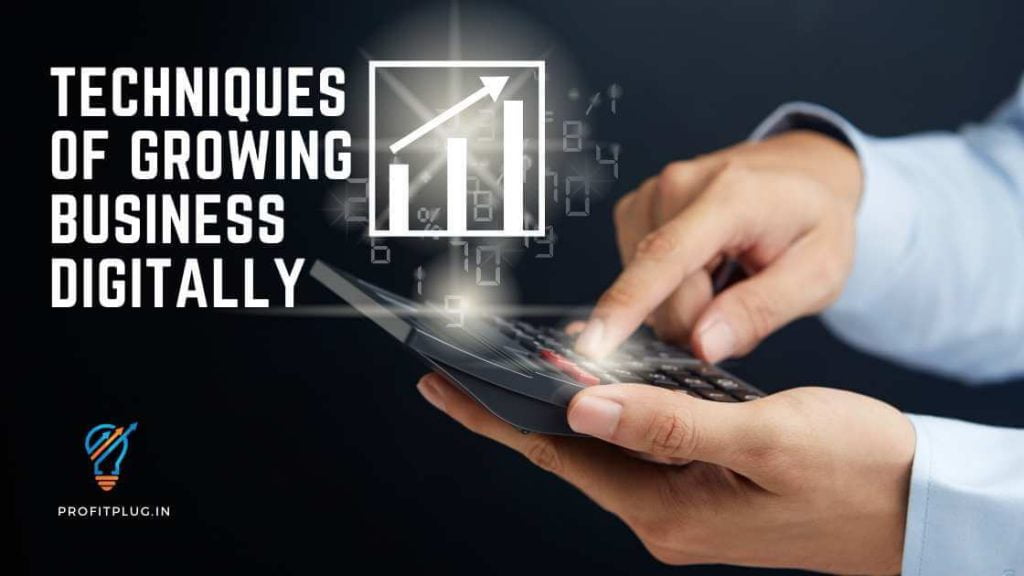
In the era of technology, where everything goes on a click or touch. It’s time for the companies to move towards digital methods of promotions. Today, I’ll tell you some of the techniques of growing business digitally & how Profit Plug can help you hit your objectives.
Dematerialization of documents, email, cloud, collaborative tools, software technology has invaded the corporate world and is forcing it to transform. Put odds on your side, and initiate the digital transformation of your business, essential to the growth for the company.
Digital: Efficiency and profitability by simplifying and improving processes
The overhaul of business processes, thanks to digital technology, leads to substantial savings in time and energy. Digital technology has often been confined to the “customer sphere” with the only interlocutors involved, sales or marketing managers, and sometimes, if it exists, the management of information systems.
Digital: Questioning your business model
The challenge is to integrate digital at the heart of the company’s strategy. Companies that are doing well in the digital age are the ones that best support a dynamic of innovation. When the digital transition is already well advanced in a market, the redistribution of value has taken place in favor of new entrants who often position themselves down the value chain. Understanding the challenges and opportunities related to digital allows us to go further and reinvent our business model in terms of digital:

- Transforming the customer experience through digital
- Reconsidering positioning on the value chain
- Consideration of mobile as a fully-fledged platforms.
- Understanding the challenges of big data.
The two critical steps for a relevant digital transition!

First, a digital diagnosis or audit on the maturity of the organization and secondly, an action plan and recommendations to initiate change around good practices.
1. Carrying out an in-depth diagnosis
Carrying out an in-depth diagnosis of the digital maturity of the audited organization and the methods of marketing the offer of order products or services, the opportunities, and threats linked to digital transformation, the identification of situations at risk for employees.
Our investigative approach for this audit uses the Ethno marketing method: an anthropological approach to consumption that analyzes practices and uses. This method of analysis makes it possible to very finely understand the actions of your staff (employees, executives, management) for a coherent digital transformation that places people at the heart of the change system.The diagnosis revolves around the four pillars of digital transformation (source TALENCO):
a. TECHNOLOGICAL: The technological and material dimension (equipment, quality of connections, software, etc.)
b. CUSTOMER: the new strategy, the new “business model,” the BIOPAU client (Talkative, Impatient, Omni (in the sense of omnichannel), Shared, Autonomous, Unique), the client (whose very notion is to (re) define) at the heart of the company’s value chain, the customer and the service offer?
c. COMPETITIVE: competitive risk or not, the arrival of new competitors…
d. SOCIETAL: taking into account the values of the network, its location, and territorial involvement, new expectations such as respect for the environment, ethical behavior, sustainable solutions, short circuits, “digital native” generation, etc.
This diagnostic highlights the itinerary of digital practices by the different actors of the company/association (employees, managers, partners, customers) in their daily life, at work, in communication, in the exchange between internal staff, with partners, in private life. We highlight the benefits and contributions of digital technology daily, and we highlight the limits, brakes, and weaknesses of digital technology.
The field survey also makes it possible to show the strengths of the company and its weaknesses vis-à-vis digital (technological, customer, competitive and societal), as well as the points of vigilance (IT security, compliance with the GDPR, the rules of the CNIL on data processing, right to disconnect the employee).
2 - The organizational transformation action plan structured around four axes:

Define the actions for each of the following themes: digital culture, changes in professions and skills, new working methods, new managerial and governance practices; For each step define the objectives and expected results; Plan actions through a provisional implementation schedule.
Define the actors associated with the deployment of the plan, the types of aid, the partnerships envisaged. To grasp digital transformation as an agent of change within the company and with the ecosystem (customers, prospects, suppliers, service providers, state, civil society), we must put people at the center of concerns of digital transformation as well as the values of organizations.
Within the framework of recommendations for actions for the digital transition, several points must be distinguished:
First of all, it seems essential to understand the “system” of the company or association in which different actors are involved (management, administrative staff, technical staff, administrators, shareholders, customers, professionals, partners, etc.). These actors are not engaged in the same way in the digital transition and must, therefore, be trained and informed in a specific way.
It also seems essential to take into account the size of the organization and its different levels of digital maturity. Each company has very different technical, human, and material skills. It is essential to take into account this disparity in actions so that everyone advances at their level (within the framework of a group, a franchise, a network)
The activities carried out must be SMART (specific, measurable, acceptable, realistic, and temporally defined). It is necessary to act in stages “step by step” to take into consideration the level of each company and to make everyone grow up to their potential. The objective to be achieved must be simple to understand, clear, precise for all the players.
The digital tools should not overshadow the importance of the human and physical-face meeting. To encourage change, we recommend face-to-face actions that allow direct communication with the protagonists of the project, and digital is used in parallel and in a second step, to facilitate remote discussions. But in no case, in our opinion, should not hide this aspect of physical meetings and exchanges between teams, which is the foundation of any successful digital transformation.
It seems necessary to us to reason in the situation: digital is neither good nor not right, there is no perfect solution. The objective is to mix distance and face-to-face depending on the conditions to extract the strengths according to the action methods and the human potential of the organization.
The three levels of digital maturity of a company
These actions adapted to the level of digital maturity of the organization, in connection with the 3 phases of the digital transition. (Some companies are in step 1, others in step 2 and some in step 3). The digital transformation goes through 3 main stages:
1. Put the problem with wisdom around some essential reflections
- Human created digital and digital impacts human
- Digital evolution, social progress that needs to evolve
- If you don’t move, you lose control
- To develop, you must EVALUATE
2. Evaluate to revolve around three pillars
- Accept the very principle of change (Act that the world has changed – Demonstrate your ability to live in today’s world – Know your generation, capture your needs and seek to meet them – Communicate in language and communication channels today – Choosing to grow – Knowing that our way of life has changed – Learning to live differently)
- Change paradigm (The POINT of view revises DIGITAL MOVES BENCHMARKS – We exchange individually – We have more opportunities – We discover new risks, new threats – We learn to work individually)
- Change your approach (Disrupting is changing change – Preparing for change is riding the wave – Provoking change is choosing your path – Living is changing – Changing is fun)
3.Create value

- To locate ourselves: where are we? What do we regulate? analyze the challenges of digital technology to overcome fear
- Get involved: Where are you at? Culture of governance: from analogue to digital – What to do? Invent a governance and regulation model adapted to the digital environment (innovation and creativity)
- Take action: Where are you at? Governance and regulation: from thought to action – What to do? Change management and reforms.
Conclusion
The high visibility offered by digital tools today: website, social networks, etc. makes it possible to extend its catchment area and thus get in touch with new customers. A company that has an active internet presence reassures and lends credibility to its image. It helps to convert customers who would not have been seduced by the company’s offer through its only offline presence. The development of a coherent proposal between the different offline and online channels makes it possible to increase the average annual expenses of each client.








